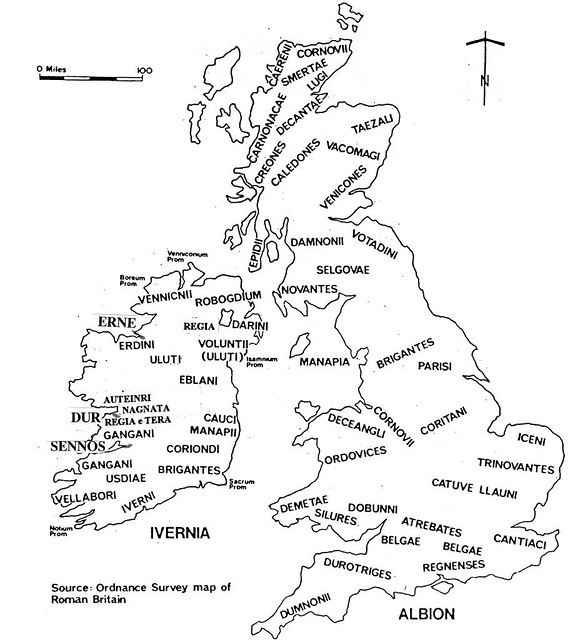Ptolemy’s Map oh the British Isles c150 AD
The traditional understanding of the history of the Venniconian Kingdoms of Donegal maintained that at some time in the late fifth century the sons of Niall of the Nine hostages, Cairpre, Conaill, Enda and Eogan had launched an invasion into that territory from Tara, having defeated and conquered the indigenous people, or at least the rulers of those people. The four brothers were said to have divided out the territory of Donegal between them and each then established a kingdom which subsequently bore his name. In one form or another these kingdoms were believed to have lasted for all of the early mediæval period.
Collectively these kingdoms were never linked but are known to us now as the “Northern Ui Neill”, who went on to conquer the rest of western and central Ulster. Two of the kingdoms, Cenel Conaill and Cenel nEogan, were said to be the most dominant and for about three centuries after their establishment, the kingship of the whole territory was shared between them. In addition, when each of their kings was ascendant, they respectively claimed provenance of the prestigious kingship of Tara, which seems to have had some sort of overriding national influence. The ancient principality of Tír Eogain’s inheritance included the whole of the present counties of Tyrone and Londonderry, and the four baronies West Inishowen, East Inishowen, Raphoe North and Raphoe South in County Donegal.
As we now know, however, that story is a later propagandistic fiction, rather than a summary of what actually happened. Almost certainly it was given its classical form by and on behalf of the Cenel nEogan, during the reign in the mid eighth century of their powerful and ambitious king, Aed Allan, who died in the year 743. Whatever his actual victories and political successes, they were underlined by a set of deliberately created fictional historical texts which reported to give him and his ancestors a more glorious past than they had actually enjoyed. The same texts projected his dynasty back to the dawn of history and created a new political relationship with the neighbouring kingdoms. Whatever the initial reaction to them, these political fictions were plausible enough to endure and have been ultimately accepted as history by most commentators over the past thirteen hundred years. Aed’s pseudo-historians were probably led by the Armagh Bishop Congus, who exploited the opportunity provided by the alliance with the King to advance the case for the supremacy of his own church. Congus died in 750.
There appears to be no evidence that any of the rulers of the Venniconian Kingdoms of Donegal were related by blood to Niall of the Nine Hostages or to the Ui Neill. On the other hand it seems that there is evidence that Cenél Conaill were a Cruthin people associated in some way with the Ui Echach Coba and other east Ulster peoples. The Cenel nEogain, on the other hand, may well have had connections with the Dal Fiatach of maritime Down. The remarkable fact in all this is that of the groups said to have belonged to the Northern Ui Neill, Cenel Cairpre may have been the only genuine decendants of Niall of the Nine Hostages to have invaded South Donegal in the sixth century. And whatever evidence we have for the mid sixth century seems to show that it was the Cenel Conaill, rather than the Cenel nEogain, who were dominant among the Donegal Kingdoms at that time.
Conall Gulban , perhaps as Conall Cernach of the Ulster Cycle, is the figure most closely related to the ancestry of the Cenél Conaill. Whether he existed or not as an actual person, his name demonstrates a powerful political reality of some sort, in that he was definitely the ancestor of the fully historically attested Cruthin people of Ui Echach Coba of County Down, the Conaille Muirthemne of north Louth, the Sil nAedo of County Meath, and the Clann Cholmain of County Westmeath. The rise to power of what was said to have been Conall Gulban’s immediate descendants is equally something of a mystery. And among those descendants was our Colum Cille (Columba), the founder of the Monastery in Iona, where ironically in an Irish context the practice of keeping Annals and therefore the study of history seems to have been promoted.
We know almost nothing genuinely historical about Colum Cille’s early clerical life prior to his departure for Iona. On one occasion Adomnán writes that “this blessed boy’s foster-father a man of admirable life, the priest Cruithnechan” was apparently responsible for the child Colum Cille In view of the identification above that the saint’s people, the Cenél Conaill, actually belonged to the Cruthin, the priest’s name, which is a diminuative of that, may be very significant indeed.
To be continued
